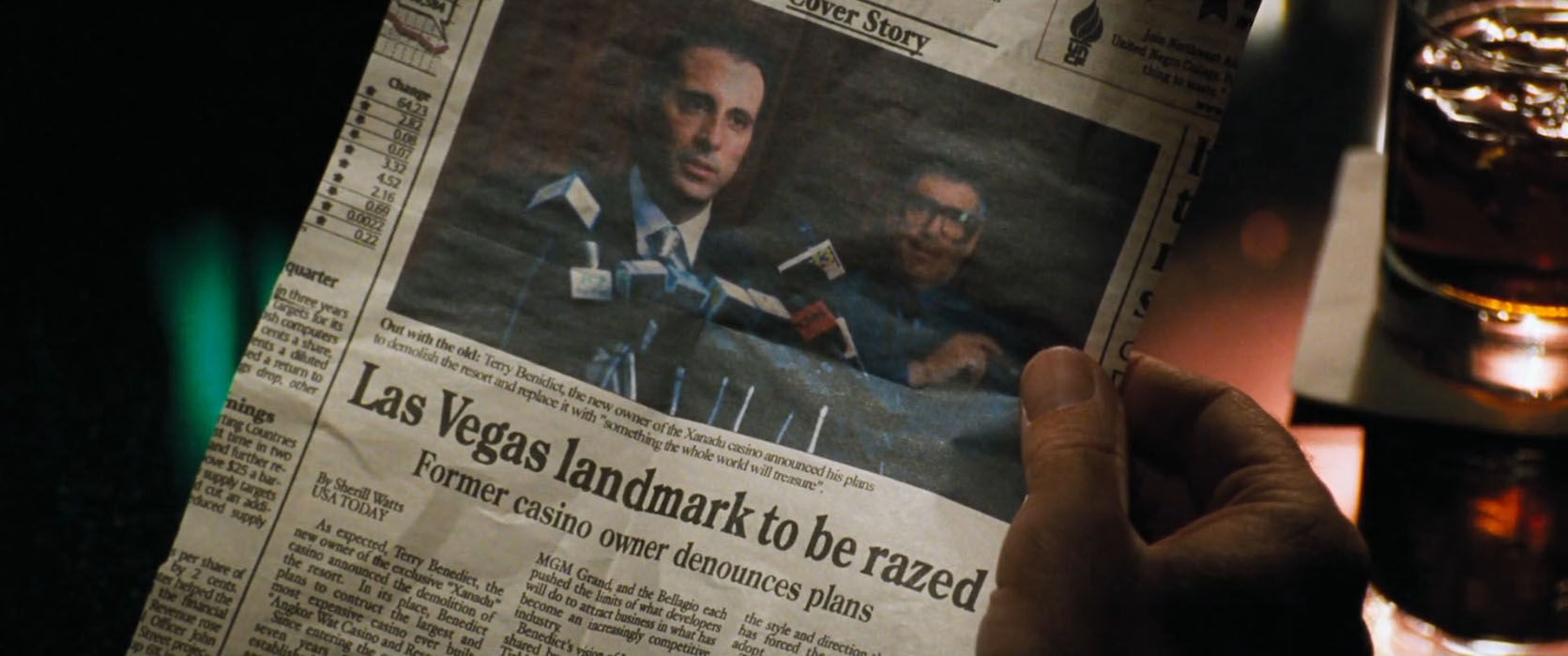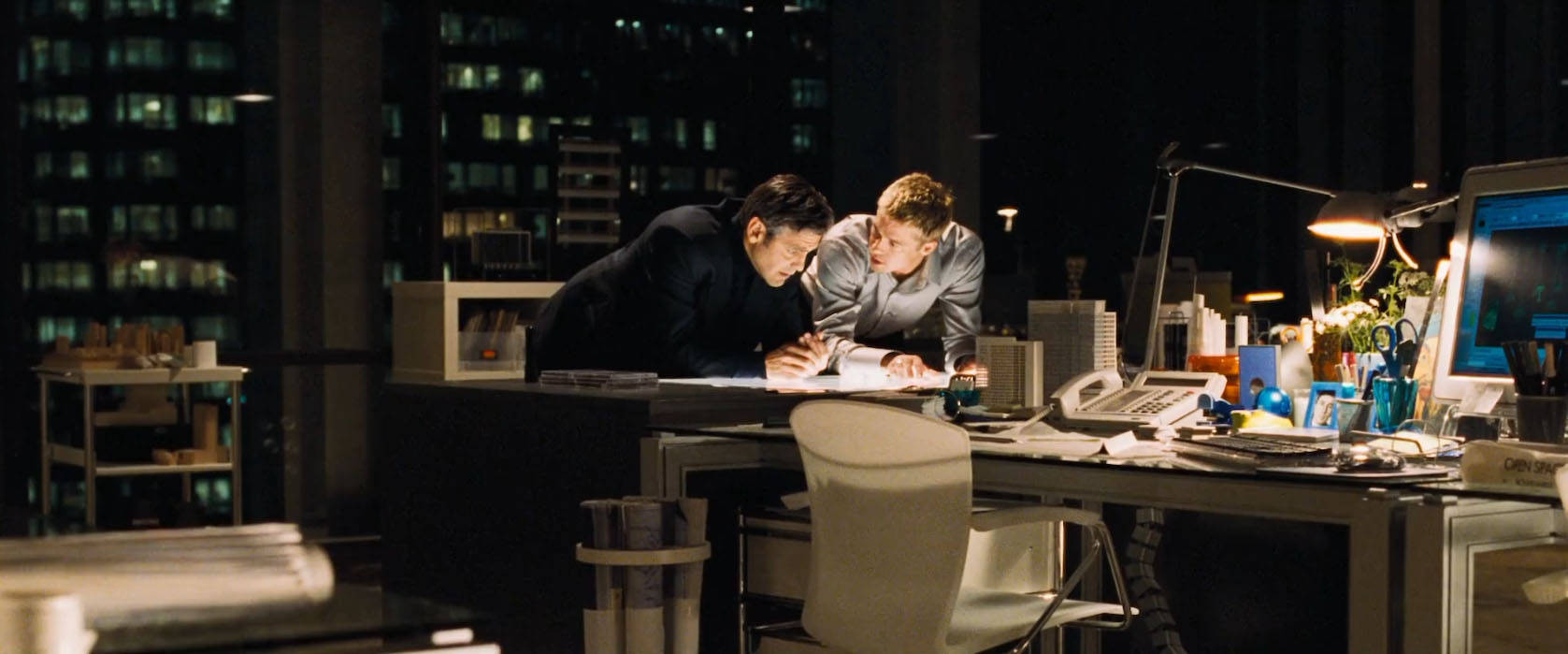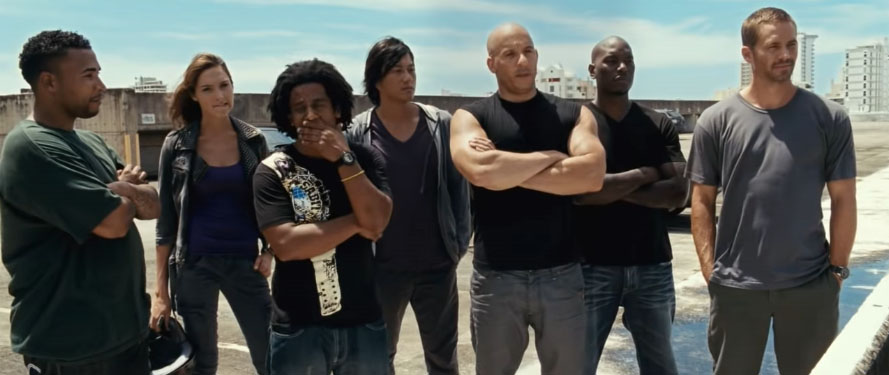I was hoping the next installment of the scenario structure challenge would feature a battlefield scenario structure, but what I did instead was beat my head against a wall for six months failing to come up with a structure that made sense. (The only thing I really came up with that seemed to have a chance of working well also featured such a massive amount of over-prep / wasted prep that I couldn’t reasonably recommend that anyone actually use it.)
So instead I’ve shifted my attention to a different target: Ocean’s 11.
(The good one. From 2001.)
Ocean’s 11 is a heist film. Danny Ocean puts together a crew of eleven criminals to simultaneously rob three Las Vegas casinos owned by Terry Benedict. Once the crew is recruited, over the course of the rest of the film we see them plan the heist, cope with a number of unexpected complications which disrupt their plans, and then execute the heist.
Heists are a fantastic scenario structure for a GM to have in their pocket. Heists aren’t limited to cash robberies: You need a thing (document, artifact, maybe even a person). It’s being held some place under heavy security. Come up with a plan to circumvent that security. Carry out your plan and get the thing you need.
That structure is incredibly flexible in its utility. It can be used with endless variety in support of any number of scenarios.
PLANNING THE HEIST
The heist scenario superficially resembles the location-crawl (usually featuring a room-and-key design), but with the – very important! – distinction that the PCs are expected to know the floorplan and some (or all) of the defensive measures present before the heist actually begins. In this it also closely resembles the raid structure, but the difference is that, whereas in the raid scenario the PCs can quickly figure out the floorplan and defensive measures largely through observation in the immediate moment, in the heist discovering these elements usually requires additional effort during the prep phase of the heist.
The heist structure is heavily player-driven, but if the players haven’t done proper heists before, they can prove unusual enough that the GM should let the players know that they have opportunities they might not normally consider viable. This is particularly true specifically because of the heist’s similarity to the location-crawl: Players may assume that they’re “supposed” to engage the heist in the same way that they engage a traditional dungeon.
Once players get comfortable with heists being part of their toolkit, things can start getting really interesting: You won’t necessarily prep something specifically to be a heist. You’ll just prep a situation and it will be up to the players to decide whether or not a heist is the right solution for that situation.
The heist structure consists of five steps.
STEP 1: IDENTIFY THE SCORE. In Ocean’s 11 (like many heist movies), this moment actually happens before the movie begins. But we see a suggestion of it in a newspaper clipping Danny Ocean is studying early in the film:
Often the target of a heist will arise organically out of other events. An urbancrawl structure might allow the PCs to dynamically search for scores and then choose their target. A patron, like “Mr. Johnson” in a Shadowrun game, might hire the PCs as freelancers to target a specific score.
STEP 2: GATHER INFORMATION. The next step is for the PCs to gather information about their target. This should include being able to gain access to some or all of the blueprints and defensive measures in the targeted complex. It may also include an event schedule, which will often feature one or more opportunities for performing the heist (by either providing unique access to the target and/or providing cover for the operation).
In Ocean’s 11, Danny Ocean and his partner Rusty Ryan exploit contacts they’ve made to gain after hours access to the files of the security firm that designed the Bellagio’s vault. They’ve already identified, from their previous research, that the ideal time to stage their heist will be on the night of a big fight (which will provide both a distraction for their operation and also increase the amount of money in the vault for them to steal).
In prepping a heist scenario, the GM should give some thought to what form the Gather Information phase might take for the target, but they should always remain open to alternative thinking from the PCs.
It’s important for the GM to remember that, in a heist scenario, the expected outcome is for the PCs to succeed in getting this information. That doesn’t mean it’s guaranteed: The expected outcome of combat in an RPG is for the PCs to win, right? But that doesn’t mean it always happens. But GMs can sometimes get a little too enamored of keeping their cards close to their chest, and you may need to consciously remind yourself to fight that instinct: 90% of the fun in a heist scenario comes from seeing a problem and coming up with a solution for it. Only about 10% comes from being surprised by the unknown in the middle of the heist (and that will usually arise organically as the heist plays out).
STEP 3: ONSITE SURVEILLANCE. After the initial gathering of information, most heist stories will give the protagonists an opportunity to conduct onsite surveillance before the heist happens. This surveillance allows them to gain information they missed or were unable to gather earlier, clarify the information they already have, and/or discover that some of their information was inaccurate or outdated (and now they have a whole new set of problems to solve!).
In the case of Ocean’s 11 this is relatively easy for Danny and Rusty to achieve because the casinos they’re robbing are public spaces: They literally check into the hotels and can have their crew scope out the place at their leisure.
Other targets, however, may require the PCs to take advantage of special circumstances (or create those circumstances for themselves). The event schedule they found in Step 2 can provide opportunities not only for the heist itself, but also for surveillance. In other cases, they may need to interact with the target under false pretenses or using forged credentials in order to carry out their initial surveillance.
In prepping a heist, it can be useful to figure out explicitly what information can only be obtained through onsite surveillance. One really easy division is to make it easy to obtain floor plans of the target, but to only be able to ascertain limited information about the security measures in place without being onsite.
When running the surveillance opportunity, once again remember that the expected outcome is for the PCs to succeed in carrying out their surveillance. Barring complete and utter catastrophe, the worst outcome for the PCs should be only one of the following:
- They only get some of the information they need
- They get misleading information
- The do something sufficiently suspicious that security is heightened or changed
STEP 4: PREP WORK. Possibly running in tandem with the onsite surveillance, the team will also need to make preparations for the job. This prep often takes the form of altering the information the PCs have received – creating new entrances, blinding security cameras, subverting guards, etc. It may also involve creating bespoke resources (or simply shopping for necessary supplies).
In modern or science fiction heists, prep work almost always includes figuring out some way to tap the security feeds so that the PCs can monitor the entire facility. If you’re not comfortable improvising what they see, use adversary rosters combined with daily schedules so that the PCs can figure out the “usual routine” at the site.
STEP 5: THE OPERATION. Finally, the operation itself. The PCs try to carry out their plan.
In running the operation, there may be one or more twists: Unexpected circumstances that the PCs didn’t anticipate or that they missed in their research. These twists can either be gotchas (twists which the GM prepares ahead of time and which the PCs have no way or anticipating – “Oh crap! Mrs. Roberts came home early!”) or complications arising from failed checks (either during their prep work or during the operation itself).
In my opinion, you’re generally going to want to rely more on complications rather than gotchas. First, skipping the gotchas will save you from unnecessary prep work. Second, in my experience it’s simply more interesting for the players to be able to look back and understand where the complications are coming from.
(Which is not to say you should never use a gotcha: One really great gotcha can elevate a scenario to the next level.)
To break this down more explicitly, successfully executing a heist will usually involve a series of skill checks. A single failed check should not cause the entire plan to immediately fail. Instead, you’ll generate complications using fail forward techniques. These complications on failed skill checks are why you can get away with giving the PCs perfect information during Step 2 and Step 3: Among other things, you can use complications to introduce “oh fuck, he got a new safe” obstacles that effectively alter or reveal gaps in the information the PCs acquired on-the-fly.
In Ocean’s 11, for example, you can see how one complication can trigger an escalating chain of additional complications, constantly creating new and interesting problems for the PCs to deal with: Basher Tarr’s prep work turns to shit when the demolition of a casino inadvertently scuttles their plan for cutting power to the casino. (That might be a GM-prepped “gotcha,” but is more likely a complication arising from Tarr’s original Electrical Engineering skill check.) To solve the problem, the team has to put together a mini-heist to boost an EMP generator. During that heist, however, their greaseman injures his hand. And then, when they deploy the EMP, it blows out the team’s earpieces so they can’t communicate any more.
Finally, to reiterate something of primary importance: Avoid twists of any type that automatically scuttle the entire job and/or negate all the PCs’ planning. Not only do they suck, they will also strongly discourage your players from pursuing heist strategies in the future. It’s much more interesting to create a new problem and let the players figure out how to solve it.
ON THE SUBJECT OF BLUEPRINTS
Heists will benefit greatly from having player-friendly versions of the blueprints that can be given as a handout. It’s well worth your time as the GM to spend the time to make these. In fact, you might want to prepare several:
- A full blueprint (i.e., a complete map of everything in the complex)
- A version with some inaccuracies (what these are is situational; for example, maybe the players get their hands on an older set of blueprints from when the facility was first built and it lacks newer features or secret areas added by the new owners)
- Partial versions, particularly those reflecting limited knowledge of certain underlings who might be questioned. (Although it may be easier to simply sketch these ad hoc as they come up during play.)
PREP CHECKLIST
Okay, so what does the GM need to prep for a heist scenario?
- Blueprints (both the GM’s and those intended for PCs to discover)
- Defensive Measures (most likely including adversary rosters, security cameras, traps, etc.)
- Event schedule (including surveillance and heist opportunities)
- Gotchas (optional)
It’s actually a very short list. Everything else flows out of the process of play, rather than any sort of laborsome preparation.
A FEW MORE THINGS ON THE MATTER OF HEISTS
COMPETING GOALS: In Ocean’s 11 robbing Terry Benedict isn’t Danny Ocean’s only goal. He’s simultaneously using the heist to win back his estranged wife. In the course of the movie we’re led to believe that this goal is in conflict with the goals of the rest of the team, and although that eventually turns out not to be true (everyone except the rookie Linus was onboard with what Danny was doing and actively assisting him) there’s no reason it can’t be true for other heists. Introducing multiple, overlapping goals into a single heist is a great way to spontaneously generate more complications and more interest.
NO AUDIENCE TWISTS: On the note of perceived truth versus actual truth in heist stories, it should be noted that most heist movies will feature a twist for the audience. This usually takes the form of thinking that something has gone wrong for the team, but then it’s revealed that the “problem” was actually part of the plan the whole time.
This is an example of where playing through a scenario in an RPG is fundamentally different from being a passive audience member of other storytelling mediums. These types of audience-focused twists simply aren’t possible when the participants ARE the audience. And that’s okay. RPGs offer different forms of reward than passive viewership does.
COMPETING TEAMS: An advanced technique for adding interest to a heist is to add a second team onsite. They might be attempting the exact same heist, or maybe they have a different goal. Either way, their actions can add both complications and opportunities for the PCs.
BEYOND VEGAS
For a very compact version of the heist, consider the opening of Mission: Impossible (the 1996 film). The job at the Embassy at the beginning of the film is a tight little heist, and adds the additional layer of complication by having a traitor on the team.
For a more action-packed heist, look at Fast Five. Often the “ideal” image of a heist features a clean job – the team gets in and out without being detected. But that’s not the only way to run a heist. Sometimes the plan will call for big guns and fast cars. Sometimes the big guns and fast cars will come out because the plan has gone sideways.



















Oh, nice, I’m really glad you returned to this series.
If some light self-promotion is allowed, please permit me to mention the heist adventure I wrote for the 7th Sea (2nd ed.) system, called “Sea’s 7”!
One of the neat features about 7th Sea is the “Dramatic Sequence,” which is basically an organized way for player characters to show off their skills in a social scene without having to constantly make rolls against things. This mechanic really sings when the characters are all working together towards a common goal using different strengths: or in other words, when they are Casing the Joint and then pulling off The Heist!
I designed this Adventure in more or less the structure you have here. They get a chance to gather intel, then to go on-site and see what’s what, then to actually carry it out. All along, there are opportunities to make things easier for themselves (find a secret, identify a compromise-able guard, find a place to stash some tools, etc.), and consequences for drawing unwanted attention or being indiscreet.
There are actually several possible Big Twists layered in here, depending on what the players do and how they play it. The Twists arise organically from the situation and the nature of the NPCs, so they at least make sense in retrospect and might be predictable by astute players! There are also several non-obvious “prizes” that are much more valuable than the nominal heist target, if the Characters stumble across them.
So anyway, it works pretty well, and it’s a ton of fun to play! Happy to send you a copy if you’d like!
How do you deal with the “infinitely gathering information” problem I’ve seen players do in heists? I do think it’s a common joke amongst shadow run players that they have to know every inch of the building, security, and where the ice cream machines are before they even plan out the heist. This can mean several boring sessions of checking, when really they should have started the heist by now.
1. Impose a time limit. You can keep trying to repeatedly gain a particular piece of information, but eventually you’re going to run out of time.
2. Enforce meaningful consequences for failure: You can just keep trying endless new things to get the piece of information you want, but every attempt is a gamble that can result in tipping off your target and making the job much, much harder. (Other consequences are also possible; that’s just the most obvious one.)
3. Use Let It Ride techniques. “The check you made is the result you get. You can keep narrating new things your character is doing, but the information they got was determined by the one check and isn’t going to change.”
4. Further emphasize this point by using narrative resolution techniques. Leaning into the greater control narrative resolution techniques can give to players in terms of defining what prep work will be effective can also directly assist with this problem: If they know that they didn’t “guess wrong” about what research approach they were “supposed” to take (because they’re the ones defining the research approach), then they’re less likely to keep trying to guess new options.
Collectively, your goal is to make the resolution broader and make the resolution conclusive.
5. Be forgiving during the heist. In my experience, most groups who become obsessed with over-planning operations (whether heists or otherwise) are doing so in reaction to bad experiences where GMs raked them over the coals. The advice above about not torpedoing an entire run based on one bad check applies here.
6. Just say it: “You’ve learned everything there is to be learned. Let’s move on.” The structure presented here can assist with that because it breaks the information gathering into two distinct phases. You can say, “You think you’ve learned everything you can without doing some actual onsite surveillance.” And advance things to the next phase.
7. Aggressively frame it. “Your planning complete, you’re outside the target. What positions are you in?”
8. Run some sessions of Blades in the Dark, which uses a mechanical structure that aggressively eschews heist planning entirely, to get them comfortable with playing heists that aren’t planned to the nines.
Hi, Justin. Long time reader, first time posting. I’m from Brazil, so if my English is a little broken, sorry in advance
Having just read your take on Dragon Heist, seeing this article was not really a surprise. I was hoping you would take your experience with remixing DH to develop a game structure for Heists.
As I see, your structure is in alpha stage, and you still haven’t developed a proper terminology for describing the elements of a heist adventure. This is my poor attempt to create one. All of them sync with the ideas of your article, but I think it gives me of a framework to structure a heist
Prize: the ultimate goal of the heist. You could also create secondary goals for some members of the party, but they should not obfuscate the Prize
Safeguard: the last obstacle between the Prize and the Players. It can be a literal safe, a monster, a puzzle etc. Getting information on the nature of the Safeguard can be a major part of the gathering information part of the adventure
Response Teams: those are dynamic groups of NPCs that respond to player’s actions. If the team know the pattern of those responses (the Routine), they can plan accordingly
Routine: it has three components: a) who is the response team; b) how long it takes to respond, and; c) what is the route
does it takes to get it? You can also have a fourth component, that is HOW does the response team is alerted.
Stationary Guards: those are immobile obstacles that the party have to overcome, be literal guards, surveillance cameras, locked doors etc.
Security Checkpoints: on a heist situation, sometimes the players advance to a point where, if they’re there, the NPCs will assume that they have permission to do so (provided they’re not calling huge amounts of attention to themselves). A security checkpoint is a transition between a cleared section and a secured one.
Secured and Cleared sections. A secured section is a place with active surveillance. A cleared section is a place where the PC’s can navigate without being bothered by security. An area can be cleared or secured depending on PC’s actions
Entrances
Main: it’s everyman’s way of getting in the place
Backdoor: it’s the entrance for employees, authorized personal, etc
Side door: it’s a hidden entrance. Will not be show on most blueprints
Exit routes: may or may not corresponde to the Entrances
I’m sure you can expand on this list. Keep being awesome!
What about using the John Harper clock mechanic to prepare the heist?
1) Each action in the prepwork fills the clock
2) If you start the heist before the clock is full, you have a significant bonus to your rolls (for example, the security is less strict or the DC is lower for some actions)
So the players might find a good balance between over-preparing, and use the extra time to find the best moment to strike vs doing everything at the last second.
What’s your take on the “flashback” mechanic for an heist?
Great breakdown! Very well thought out. Just curious, has anyone actually run something like this? I’d be curious to know whether heist scenarios are truly any fun or not.
The wonderful thing about heists in movies is that, as the viewer, the heist itself is being revealed as it’s being performed. We experience joy while discovering how the players on the stage cleverly execute their plan, which was previously hidden to us. The *reveal* is the fun.
In a game, however, the players already know what the steps will be, and it’s merely a matter of executing them properly during the operation to achieve the goal(s). Sure, there can still be unexpected twists to add some tension… but in the end, I’d love to know whether running that game plan actually produces a rewarding experience.
I liken it to a windup toy. You know what the toy is going to do after you wind it up. I suspect that the foreknowledge of the outcome is what turns the wonder of a heist-style movie into something less than on the tabletop.
If anyone’s been successful with a heist, please share! Would love to know the details of what the players liked. And why.
On another note: Justin, you’re killin’ it. This site is awesome. I really wish I had read your review of Waterdeep: Dragon Heist before I started. We just went through Chapter 3 last week. It was nothing short of exasperating.
> Just curious, has anyone actually run something like this?
I’ve run a few of these for Shadowrun, where I feel like they should probably be the assumed game structure, and a fair number for D&D. I guess I’ve also coded some for online games.
My D&D ones always arose naturally from sandbox play. Those had mixed results. Some were among the best sessions I’ve run. Others fell flat.
In general, the best sessions were when the heist emerged naturally but I had a good situation prepped or could handle the front-loaded improv. The flat sessions were when I couldn’t fill in the structure fast enough for the players or straight-up missed pieces.
But D&D/Pathfinder feels fairly well-equipped for heists with the dungeon roles translating well and the magical back and forth in the spell list. But if you have a group with a strong expectation of combat, their heists can play out a lot like dungeon crawls.
How do you feel about non-linear storytelling techniques in a heist adventure? What about giving the players X chances to go back and run a flashback scene to solve some problem that would otherwise crop up?
That gets the players right into the action, and avoids the dreaded, “Have we discovered everything there is to discover” problem.
If one were to accept some form of flashbacks in your adventure format, how would that format have to change?
Regarding battle scenarios, I’d like to suggest you take a look at Ars Magica’s supplement Lords of Men, which includes a narrative solution to huge battles. The short of it is, breaking up the battle into significant scenes that either make success more likely or stops the enemy from making their success more likely. Like, for example, infiltrating the cattle to open the doors, holding a pass for a number or turns to allow reinforcements to arrive, face an enemy hero in combat, stop an assassin from killing a leader in your faction, etc.
I just stumbled across a game on RPGNow called Dusk City Outlaws which describes itself as “A Roleplaying Game of Capers, Heists, and Other Thievery.” I’d never heard of it before, and I’m not planning on buying it, but I wondered if you were familiar with it and had any thoughts about how it handles heists. Or, if it’s as new to you as it is to me, you might be interested in taking a look at it.
@10: “…infiltrating the cattle to open the doors…”
I suspect you meant infiltrating the castle, though I suppose you could take a leaf from Odysseus’ playbook and sneak in with the herd by roping yourselves under their bellies.
@12 Yes, obviously a mistake, but funny. But I can definitely picture quite a few antics that can be stolen from the old metis.
I think, it is possible to use audience twists in RPGs, if PCs are not working for themselves, but hired by some questgiver. Then this questgiver can have his own plan, partially unknown to the PCs… And when this part of his plan come into play, PCs (and players) may think, that something has gone wrong for them, but then it’s revealed that the “problem” was actually another part of the questgiver’s plan, which has been unknown to PCs and players.
I had never thought of that approach, Angon. That’s a fantastic idea!
Re: Dusk City Outlaws. I’m not personally familiar with it, but my friend James was describing it to me in quite some detail. I’m always interested by any RPG that bills itself as “off-the-shelf” at this point, but it remains a little hazy to me how DCO is achieving that.
Definitely something on my List of Interest, although at $75 I probably need a bit more prodding before picking it up.
This series is amazing! Best GM advice I’ve found so far. Thank you! I’m interested in your thoughts on battlefield – I’ve always found that to be tough.
I just ran a heist scenario with this structure in mind, to a disastrous and player-frustrating effect. There was a certain key problem with my implementation. In retrospect it now seems blindingly obvious.
When framing the scenario, I contrasted heights with raids and mentioned the four phases. I also made it clear the PC’s had many tools at their disposal, as well as the stakes of what would happen if they tried to Leroy Jenkins it, and left them free to make their own paths toward success. They came up with a couple good solutions I wouldn’t haven’t thought of, including skipping the onsite surveillance phase by having the team’s psychologist profile a disgruntled employee and then lean on them for intel. That was a brief moment of Cool.
But most of it was a complete, agonizing, head bashing drag.
The problem was this: although IN THEORY they knew that planning and prep should come after information gathering and onsite surveillance, IN PRACTICE they tried to make a plan right at the beginning, before they had learned anything, and then carried that plan with them through every subsequent decision point. This resulted in three problems:
1) They wasted 45 minutes detailing an uninformed plan that couldn’t possibly have worked, and then wasted another 15 minutes revising the plan EVERY TIME THEY DISCOVERED A NEW PIECE OF INFORMATION.
2) This frustrated them, because they kept reflexively trying to plan with insufficient knowledge.
3) Ironically, the fixation distracted them from focusing on ways to gain more intelligence. Immediate questions of “How do we find out about X?” took a backseat to “How could this suicidal plan possibly work?”. Instead of identifying unknowns and trying to make them known, they just stewed in confusion.
Even the transition between “Gathering Information” and “Onsite Surveillance” was difficult. They spent a long time just staring at the floor plans trying to intuit how the security system worked before it occurred to them to question an employee. Meanwhile I was sitting there, fighting the urge to say “Why don’t you just sneak in and go look at it?”
So I concluded that the phases of the heist need be strictly firewalled in way that is far more heavy handed than I am ever comfortable being as a GM.
It’s not enough to emphasize finality when they have finished a phase (“You’ve learned all you can without direct access to the facility.”). I needed to straight up forbid them from skipping forward (“You are not allowed to plan until you believe you have gathered all the information needed to formulate that plan. And once you start planning, there is no going back and gaining more information.”)
I HATE feeling like I have to do that, because:
1) Player agency is good and it feels railroady.
2) Structure should function as a guideline rather than a tightrope.
3) Certainly they need to give some thought to planning when they decide what information is worth pursuing?
4) If I suggest to players they are not done gathering information, isn’t that the same as vetoing their decision or prompting them? Shouldn’t they have the freedom to make dumbass plans?
5) Part of me feels like placing strict boundaries on a phase sequence that only exists in the metagame would kill immersion.
But I know now that by not strictly firewalling planning from the earlier phases, and advising them to focus on each phase in isolation, they all just blur together into an unintelligible mess.
It really forced me to rethink my position on GM’s declaring finality and impossibility. Maybe when sequences only exist in the metagame, it becomes ESPECIALLY important to emphasize them in order to provide a sense of closure and a benchmark of progress. And when thinking too far forward is likely to muddle things, it becomes important to “lock” those phases until the PC’s have firmly decided they are finished with the current one.
I’ll still try to stay on the right side of player agency by leaving that choice to them, and favoring questions over statements. If they start trying to plan too early, I will ask them “Are you done gathering information?” If the answer is yes, then we move on, with the understanding that there will be no going back. If not, then there will be no planning until they believe they are ready.
If anyone else has any pointers, I’d be very grateful if you would share them with me.
I think Sean McCoy (of Mothership) has some good advice in his game under development; Heist:
“Setting Deadlines
Set a hard deadline on when the opportunity will pass if the PCs dawdle too long. Let them know that the cash will be moved from bank to bank via armored car in two weeks exactly. Or that the jewels will be on display for only a certain amount of time. Be clear about this and let them know exactly how many days they have to plan the heist.
Deadlines allow the PCs to make decisions about whether they want to move on a job early, accepting less than the maximum amount of potential cash, but as a tradeoff for perhaps less security. They also promote a “good plan today is better than the perfect plan tomorrow” mindset, where the PCs often have to make do with what they have, or can acquire, in a short amount of time.
Calling on a contact or trying to acquire the perfect disguise should take time. Let the PCs know that their character will be taking care of that problem for a day or two. This keeps things moving along towards the deadline. Travel to the destination may be a problem, the job is in Chicago, but the vehicle the PCs need to pick up is in Des Moines. You don’t have to account for every hour, but in general it’s a good idea to think of every action as taking a day.”
– http://www.failuretolerated.com/heist
Letting the players know they only have 5 days until they need to make their move, forces them to spend their time more wisely on gathering information. Ask every player what they are doing the first day. If they just sit around planning without information, let them know it will take time in-game, and move on to the next day after a while. Ask them again what they do on the second day. If they don’t want to waste their available in-game time, they should start gathering information.
To me this doesn’t feel railroady, it’s just pacing the game and making sure that time moves on. The players still have agency to do what they want with their time. These kinds of games break down if the players expect that they can essentially hit pause on the in-game time, and plan forever out-of-character.
@Pelle
Thanks for forward on deadlines. I did employ that and made it clear when running the heist. After discovering the event calendar they in fact had only 3.5 days to move on the target before they lost their opening. They were just kind of stumped as to what to do, unable to articulate what information they still needed to know, or to think of ways to acquire it. My usual Socratic method-ing + opening up to their questions couldn’t help them tease it out.
It certainly wasn’t due to a lack of information. They actually did REALLY well on their opening research checks. If anything this frontloaded too much information, and they got too locked up trying to plan with it to identify the gaps and see WHY they couldn’t make it work. Hence why I say I should have advised against planning until later.
Like you say, I should have paced more aggressively past these (in)decision points. The heist might have failed, which would have left a sour taste in their mouths, but at least it would have concluded sooner.
The other factor is more personal. I have two players that deal with pretty serious anxiety. It flairs up when they feel put on the spot and have to make a decision quickly. I’ve talked to them about it a few times; one is ok with me enforcing deadlines (and actually told me I should have done this during the heist post-mortem).
The other starts to have a panic attack if I even look like I’m about to skip them. They’ve tried a bunch of things; playing characters whose quirk is to hesitate a lot, or that rush into action without thinking. None have worked very that well. Unfortunately any detailed planning tends to bring that problem to the fore. It bleeds over into encouraging others to hesitate whenever they have to act in concert.
It’s something I’ll have to confront them about, again. I could probably use some advice on that too, since most of what’s been written boils down to either “Set time limits” or “Don’t game with those kind of people”. Which is a shame, because they very much enjoy roleplaying and are great to have in every other respect.
I didn’t read the comments, so I’m sorry for both the necromancy and the possible repetition.
I noted you said there can’t be twists “for the audience”, and I think that, in a way, you may be wrong.
Say, my PC, Emily, is in a tight situation: she is impersonating an subofficer and runs into a full-fledged officer that may figure out her disguise. So I roll and fail, and the GM says the NPC Officer alerts his superiors and imprisons Emily.
But, I come up with an idea: what if this was all part of the plan, for Emily to get to the prision section of the complex? Maybe there is a prisioner in there that we need to liberate so she also helps with the heist. So, I tell the group my idea and the GM tells me to roll Luck/whatever (if we were playing Burning Wheel, it would be a Circles test) to see if that NPC is there.
If that second roll is successful, we as a group may retcon our interpretation of the previous failure into a sort of “audience twist”.
Ok, Battlefield Scenario.
Structure Premise. Armies are in one or more divisions and a division is a single “character” at battlefield scale.
The fortunes of the opposing forces have some simple mechanic with dice rolls, and some base maneuvers – probe, assault, flank, defend, withdraw, commit reserves or send in a special force. The combination of choices determine how the battle progresses for the next battle field scale turn.
The PCs moving through the battle field and can encounter a division by either encountering a regular squad of the division, or the command squad of the division.
PC action time scale is 1/10 action scale for the armies.
Interactions with the command squad have an impact on the army scale combat at the next dice roll. Such interactions may include taking command or accepting battlefield missions (deliver a message, lead a squad to rescue an isolated position whatever).
Interactions with squads may have a minor impact or a cumulative one if the PCs go from squad to squad enhancing or damaging each squad or causing morale fluctuations.
Use the time scale and figure scale differences to keep what is happening at army level slow and in the background. What happens there creates a context for the PCs. Maybe they get caught with friendly units that are forced to retreat. Or find themselves between two opposed squads.
The PC level stuff keeps sending ripples up to the army scale just enough that the players note when they have effected key moments in the battle.
Minimal prep involves a standard squad template for each side and a command squad template for each side. Create a map of the battlefield at a size suitable to the army sizes. Strategic and important locations get a special PC level detail map.
Increase by adding special force command squad and regular squad (maybe one side has a wyvern squadron).
I’ve actually done this in D&D for 3ed several times and it was always fun. The most memorable was a group of PCs with a flying carpet trying to get a treasure out of no man’s land, when one of the armies had a black dragon as a special force.
For 5e I had a battle, long time coming, between forces led by 5 beholders and an army of swarves led by the PCs. The PCs even set up battlefield defenses and traps.
And there was the Battle of Fort Velso which got nicely documented here: https://rpggeek.com/thread/1875197/article/27471392
I’m planning a heist mini campaign for my son’s group and this information is super useful. One additional step (taken from Ocean’s Eleven, but is common to the trope), is the “Assembling the Team” phase. This can be a way for the PC’s characters to meet each other (“Jimmy’s wife’s cousin just got out and has quick hands”) and an opportunity to introduce various antagonist NPCs that could complicate the heist.
I’ve just bought the Keys from the Golden Vault book, and this post is my to-go to improve the structure of the adventures 😀
While meandering through the article I thought of other heist movies with various elements and realized that in The Dark knight Heath Ledger Joker’s heist could be very interesting to play through as a one shot. Then I realized that having the Pc’s do a heist could result in the GM having a low prep high reward scenario to run for players to hunt down the heist group as either Superheroes or Cops. Even if there is overlap of players just backfill the ‘metagaming’ as deduction because the investigator needs to communicate the information to the other players. It makes the knowledgeable one seem super smart and requires less Dm heavy handed ness or even prep. While keeping the party on track in the initial investigation. This even works well with challenge #3. One shots introducing each group would give the players a lot of familiarity with their opponents by Showing them how the opposition works without having to tell them. and the players easily know where and what they think they should find as clues as a bonus.